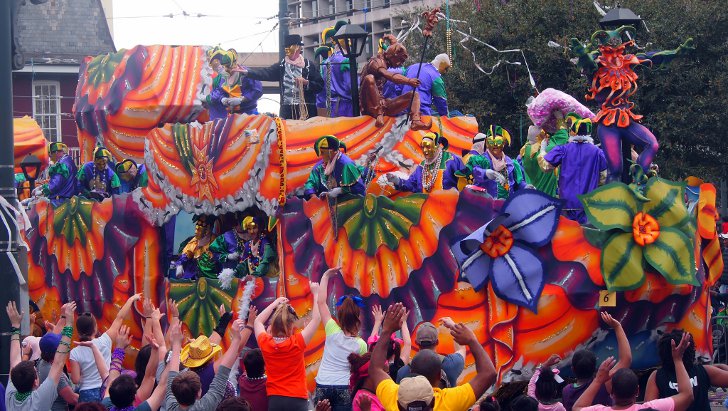The date of the first carnival celebration in New Orleans is unknown. According to a 1743 account, the tradition of Carnival balls with music, dance, masking and costuming was already established. Although Mardi Gras processions were sometimes prohibited by law, such restrictions never lasted long.
The first krewe (a social club that organizes a ball or participates in parades during the Carnival season) was created in 1856. Six local businessmen organized a secret society to observe Mardi Gras with a formal parade and founded the Mistick Krewe of Comus. By the way, it still exists and holds an annual ball on Mardi Gras night. Today, New Orleans has numerous krewes which host balls, participate in parades and are responsible for electing Rex, the king of the New Orleans carnival.
The Carnival season in New Orleans begins on January 6, the feast of Epiphany in Western Christianity. Although festivities last for over two months, the largest and most elaborate parades and balls take place beginning on the Friday before Ash Wednesday. Usually there is at least one major parade every day, many days have several parades occurring throughout New Orleans and surrounding communities.
Every parade features beautifully decorated floats with float riders tossing the so-called throws into the crowd. The most common throws are doubloons, moon pies, small inexpensive toys, and strings of colorful plastic beads. Doubloons are wooden or metal dollar-sized coins made in Mardi Gras colors (purple, gold and green) and impressed with krewe logos. Throwing beads is one of the oldest Mardi Gras traditions, it dates back to the late 19th century.
The Carnival season kicks off with a masked ball organized by the city’s second-oldest krewe, the Twelfth Night Revelers. Most oldest societies in New Orleans don’t parade in public, holding masked balls instead. Some of the biggest and most colorful parades are organized by the Mystic Krewe of Nyx, the Krewe of Muses, the Krewe of Hermes, the Krewe of Morpheus, the Krewe of Tucks, the Krewe of Endymion, Le Krewe d’Etat, and others.
One of the most famous parades in New Orleans is called the Zulu Parade. It is the first parade to roll on Mardi Gras day. The event is organized by the Zulu Social Aid & Pleasure Club, the city’s largest predominantly African American krewe known for throwing hand-painted and adorned coconuts. The Zulu Parade is followed by the Rex Parade and a number of smaller parades.
New Orleans Mardi Gras officially ends with a ceremony known as the Meeting of the Courts. At this ceremony, Rex (the King of the Carnival) with his Queen meet with Comus and his Queen at the ball held by the Mistick Krewe of Comus. Promptly at midnight at the end of Shrove Tuesday, a mounted squad of local police officers make a show of clearing the city center, announcing that Lent has begun and Carnival is over.
In 2021, Carnival parades were canceled due to the COVID-19 pandemic, but small events were held to keep the spirit of the Carnival alive.

Photo by Jessica Pepe




